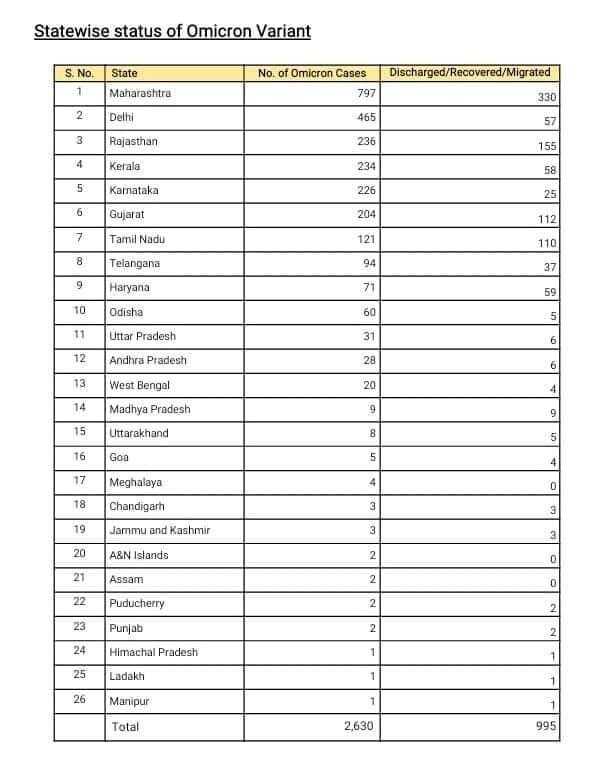According to the Union health ministry, India had 1,700 Omicron cases as of January 3. Night curfews and 50% capacity restrictions in public transportation and offices have been implemented in several Indian cities and states. According to experts, these are unlikely to have a significant impact on the virus’s transmission. The night curfew simply serves as a symbolic reminder that it is time to be concerned. Capacity limits are a legitimate attempt to reduce crowding and maintain physical separation.
The appearance of Omicron corresponded to the concept of decreasing immunity in the vaccinated population. Despite the variant’s widespread mutations and low susceptibility to neutralizing antibodies, the bulk of T-cell responses elicited by vaccination or spontaneous infection cross-recognize it.
Localized lockdown in hotspot areas will aid in the containment of Omicorn’s community spread. The best way to combat omicron is to adopt COVID-19-appropriate behavior, such as enforcing a rigorous mask rule and increasing immunization rates. The focus for India should be on improving immunizations, including booster dosage. In semi-urban and rural areas, door-to-door immunization drives are essential.
Recent press release by Government of India regarding Covid-19 virus given below :

Table of Contents
About Omicron :
SARS-CoV-2, the virus that causes COVID-19, has a variation called Omicron. It is the most recent variation as of December 2021. It was initially reported to the World Health Organization (WHO) on November 24, 2021, by South Africa. The WHO identified it as a variation of concern on November 26, 2021, and named it “Omicron”
Omicron is thought to be far more contagious (spreading much faster) than previous variants in the bronchi (lung airways), spreading around 70 times faster, but it is less able to penetrate deep lung tissue, which may explain why there is a significant reduction in the risk of severe disease requiring hospitalization.
However, because of the virus’s fast rate of spread and capacity to resist both double vaccination and the immune system, the overall number of patients requiring hospital care at any given moment remains a major worry.
Breakout: WHO has been employing genetic monitoring to track variations of SARS-CoV-2, the virus that causes COVID-19, and guides public health management throughout the epidemic.
- On November 24, 2021, the World Health Organization received notification of a new SARS-CoV-2 variant, B.1.1.529 (WHO). This new variety was discovered in specimens taken in Botswana on November 11, 2021, and in South Africa on November 14, 2021.
- On November 26, 2021, the B.1.1.529 Omicron was recognized and designated as a Variant of Concern by the World Health Organization (WHO) (VOC).
- The United States recognized Omicron as a Variant of Concern on November 30, 2021. The first confirmed case of Omicron in the United States was discovered on December 1, 2021.
Transmission Rate:
The Omicron version of the SARS-CoV-2 virus is anticipated to spread more quickly than the original SARS-CoV-2 virus, whereas how quickly Omicron spreads in comparison to Delta is uncertain. Even if they are vaccinated or show no symptoms, WHO believes that anyone infected with Omicron can spread the virus to others.
Omicron has been found in most states and territories as of December 20, 2021, and is significantly increasing the number of COVID-19 cases it is triggering. The latest state-wise report by Govt. of India press release is given below :

Symptoms :
WHO reviewed symptom data from positive cases reported in the COVID Study and compared it to data from early October when Delta was prevalent, using the most recent data from London, where Omicron prevalence is higher than in other parts of the UK.
The symptom profile of Delta and Omicron did not differ significantly, with only 50% of participants reporting the usual three signs of fever, cough, or loss of smell or taste. Omicron common symptoms are :
- A clogged nose
- Headache
- Tiredness (mild or severe)
- Sneezing
- Throat irritation
Loss of appetite and mental fog was also reported as prevalent symptoms by contributors.
These findings are consistent with a small set of data from participants who said their positive PCR results indicated Omicron infections, either suspected or proven.
Treatment:
Scientists are attempting to discover how effective existing COVID-19 therapies are. Some medicines are likely to remain helpful despite Omicron’s changing genetic make-up, while others may be less successful.
Precautionary Measures People Can Take :
The most important thing you can do is lower your risk of being infected. To ensure that you and your loved ones are safe, make sure to:
- Put on a mask that covers your mouth and nose. When putting on and taking off your mask, make sure your hands are clean.
- Maintain a physical gap of at least 1 meter between yourself and others.
- Avoid crowded or poorly ventilated areas.
- Increase indoor ventilation by opening windows.
- Hands should be washed frequently.
- Get immunized when it’s your turn. COVID-19 vaccinations that have been approved by the World Health Organization are both safe and effective.
DISCLAIMER : This and other personal blog posts are not reviewed, monitored or endorsed by Blogjab. The content is solely the view of the author and Blogjab is not responsible for the authenticity of content of this post in any way. Our curated content which is handpicked by our editorial team may be viewed here.






